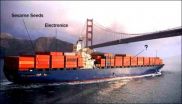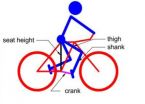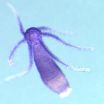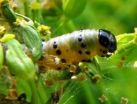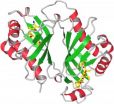(Press-News.org) Every day, thousands of cargo containers from around the world pass through our nation's sea ports carrying items we need, and possibly some that are not so welcome: drugs, explosives, chemical, biological, or radiological weapons – even human cargo.
The possible concealment of such items in containers led lawmakers to call for the screening of all ocean cargo containers—thousands per port per day. The Department of Homeland Security's (DHS) U.S. Customs and Border Protection (CBP) is charged with the critical task of securing the country from terrorists and their weapons while facilitating legitimate trade and travel, including the monitoring of what's in thousands of sea cargo containers as they pass through CBP screening. These containers must be inspected quickly and accurately, and without the business at each port grinding to a halt when they do so.
The DHS Science and Technology Directorate (S&T) and its Transportation Security Laboratory (TSL) in Atlantic City, NJ, have developed a way to test technical solutions to this need: the Container Security Test Bed (CSTB) – an outdoor "laboratory" allowing researchers and developers from government, academia, and industry to explore novel ways to detect threats in a cargo container.
The Test Bed is run by TSL engineers and simulates exactly the cantilever cranes used to unload container ships. The CSTB allows a container to be picked up, moved, and put down in minutes, mimicking both the way and the timeframe in which each container is taken off a ship and dropped down onto the dock.
"Give me the right tools – a gas chromatograph, a mass spectrometer, and an hour's time – and I can tell you exactly what's in a 40-foot container," said Dave Masters, the S&T Program Manager who oversaw the creation of the Test Bed. "But a maritime container terminal can't spare an hour. It needs its cranes to move goods, not run experiments. The CSTB gives any new sensor system a real-world workout that replicates both screening the items in a shipping container, as well as the standard loading/unloading operations at a seaport. Sensors must survive the container being hoisted up, moved quickly, and slammed down – they cannot be so delicate that they cannot survive gritty port conditions."
S&T researchers are encouraging technology developers to test any kind of sensor at the CSTB. Detection technologies constantly undergo improvements in order to detect trace amounts of substances — and do so fast.
Chemical-based sensors, currently in use for aviation security, may find trace amounts of explosives, drugs, or other illicit substances, while laser-based methods that can "read" the physical properties of target molecules detection methods are also in development.
What is the specific challenge? S&T researchers are collaborating on techniques to get a representative sample of the air inside the container to the sensor itself. Representative samples of air inside a cargo container must be captured through an air vent standard containers have, and then that sample will pass through several variations of detection sensors. This technology was demonstrated to S&T by a joint effort between MIT and Lincoln Labs in 2010.
Alternatively, sensors may be built into the cargo container and programmed to send information on any illicit content to the receiving seaport while the container is still en route to port. In October 2011, ConSearch, LLC conducted a feasibility demonstration of their in-situ chemical and radiological detection capability. The demonstration consisted of simulating a trans-oceanic voyage of a 40-foot container that contained several threat types and employed a method of using multiple sensors to obtain a comprehensive view of the chemical/radiological content.
To evaluate explosive detection methods, TSL scientists are also are testing methods to present samples to sensors more quickly and accurately.
The S&T Container Security Test Bed provides an opportunity for public and private sector partners to research and collaborate on novel ways to detect threats in a cargo containers—working together to make our shipping industry more safe, secure and resilient.
"We're exploring the art of the possible. The things we're doing, you can't do on paper. You need to get your hands dirty," says Masters.
INFORMATION:
When your ship comes in
Make sure you know what's in the cargo containers it carries - before there's trouble
2012-03-05
ELSE PRESS RELEASES FROM THIS DATE:
A new optimum design method of bicycle parameters for a specified person
2012-03-05
The optimum design of bicycle parameters has been explored by many scholars and institutes since bicycles were first invented. Professor Xin-Jun Liu and his group at Tsinghua University established a new way to design bicycle parameters according to the dimensions of the rider's body. They introduced a new perspective of the rider–bicycle system by considering the complete system as a mechanism. The group then established a new method for the optimum design of bicycle parameters from a completely theoretical basis, which may result in a new field of optimum design of bicycle ...
National Sleep Foundation poll explores transportation workers' sleep
2012-03-05
WASHINGTON, DC, March 3, 2012 – The people we trust to take us or our loved ones from place to place struggle with sleep, according to the National Sleep Foundation's (NSF) 2012 Sleep in America® poll. It is the first poll to ask transportation professionals, including pilots, train operators,* truck, bus, taxi and limo drivers about their sleep habits and work performance.
Pilots and train operators are most likely to report sleep-related job performance and safety problems.
The results of the poll are striking. About one-fourth of train operators (26%) and pilots (23%) ...
Ice hockey feels the heat in Canada
2012-03-05
The future of Canadian outdoor ice hockey – a sport synonymous with the country's culture – is being threatened by anthropogenic climate change, new research suggests.
As warmer winter temperatures restrict ice from freezing over, researchers believe the ice hockey stars of the future will have limited access to the frozen lakes and backyard rinks that have helped shape the careers of some of the greatest professional players, such as Wayne Gretzky; the Canadian considered to be the greatest of all time who started skating as a child on a rink in his backyard.
Evidence ...
Study shows brain flexibility, gives hope for natural-feeling neuroprosthetics
2012-03-05
Berkeley – Opening the door to the development of thought-controlled prosthetic devices to help people with spinal cord injuries, amputations and other impairments, neuroscientists at the University of California, Berkeley, and the Champalimaud Center for the Unknown in Portugal have demonstrated that the brain is more flexible and trainable than previously thought.
Their new study, to be published Sunday, March 4, in the advanced online publication of the journal Nature, shows that through a process called plasticity, parts of the brain can be trained to do something ...
Boosting cell production could help treat liver disease
2012-03-05
Scientists have shed light on how the liver repairs itself with research that could help develop drugs to treat liver disease.
Researchers at the Medical Research Council (MRC) Centre for Regenerative Medicine at the University of Edinburgh have discovered how to enhance the production of key cells needed to repair damaged liver tissue.
The study, published in the journal Nature Medicine, could help heal livers affected by diseases such as cirrhosis or chronic hepatitis.
Scientists were able to unpick the process of how different cells in the liver are formed.
When ...
Keep smiling: Collagen matrix promotes gum healing around exposed roots
2012-03-05
Receding gums often result in tooth sensitivity and can lead to decay of the root and persistent inflammation of the gum. New research published in BioMed Central's open access journal Head & Face Medicine demonstrates that a novel method using bovine collagen is able to enhance gum healing. This resulted in thicker margins around the tooth and, in over half the cases, complete coverage of exposed roots.
Researchers across Germany and Switzerland led by Dr Shahram Ghanaati and the dentist Dr Markus Schlee investigated the possibility of using collagen, extracted from ...
Seeing without eyes: Hydra stinging cells respond to light
2012-03-05
In the absence of eyes, the fresh water polyp, Hydra magnipapillata, nevertheless reacts to light. They are diurnal, hunting during the day, and are known to move, looping end over end, or contract, in response to light. New research published in BioMed Central's open access journal BMC Biology shows that stinging cells (cnidocytes) in hydra tentacles, which the animals use for self protection and to catch prey, are linked via a simple nervous system to primitive light responsive cells that co-ordinate the animals' feeding behavior.
Hydra are members of a family of radially ...
Does your mother know?
2012-03-05
Do your parents know where you are at night? According to 36 per cent of 15 year old boys and nearly a quarter of 15 year old girls the answer to that question, at least once a month, is no.
This is the finding from Understanding Society, a long term study of 40,000 UK households, which asked more than 2,000 10-15 year olds how frequently they stayed out past 9.00pm without their parents knowing where they were. The study, which is funded by the Economic and Social Research Council (ESRC), also found that staying out late without telling your parents is unrelated to ...
Escaping parasites and pathogens
2012-03-05
In nature, how do host species survive parasite attacks? This has not been well understood, until now. A new mathematical model shows that when a host and its parasite each have multiple traits governing their interaction, the host has a unique evolutionary advantage that helps it survive.
The results are important because they might help explain how humans as well as plants and animals evolve to withstand parasite onslaught.
The research, reported in the March 4 online edition of Nature, was supported by the National Institute for Mathematical and Biological Synthesis ...
X-rays reveal how soil bacteria carry out surprising chemistry
2012-03-05
Researchers working at the U.S. Department of Energy's (DOE) SLAC National Accelerator Laboratory have used powerful X-rays to help decipher how certain natural antibiotics defy a longstanding set of chemical rules – a mechanism that has baffled organic chemists for decades.
Their result, reported today in Nature, details how five carbon atoms and one oxygen atom in the structure of lasalocid, a natural antibiotic produced by bacteria in soil, can link into a six-membered ring through an energetically unfavorable chemical reaction. Unlocking this chemical pathway could ...
LAST 30 PRESS RELEASES:
The Ceramic Society of Japan’s Oxoate Ceramics Research Association launches new international book project
Heart-brain connection: international study reveals the role of the vagus nerve in keeping the heart young
Researchers identify Rb1 as a predictive biomarker for a new therapeutic strategy in some breast cancers
Survey reveals ethical gaps slowing AI adoption in pediatric surgery
Stimulant ADHD medications work differently than thought
AI overestimates how smart people are, according to HSE economists
HSE researchers create genome-wide map of quadruplexes
Scientists boost cell "powerhouses" to burn more calories
Automatic label checking: The missing step in making reliable medical AI
Low daily alcohol intake linked to 50% heightened mouth cancer risk in India
American Meteorological Society announces Rick Spinrad as 2026 President-Elect
Biomass-based carbon capture spotlighted in newly released global climate webinar recording
Illuminating invisible nano pollutants: advanced bioimaging tracks the full journey of emerging nanoscale contaminants in living systems
How does age affect recovery from spinal cord injury?
Novel AI tool offers prognosis for patients with head and neck cancer
Fathers’ microplastic exposure tied to their children’s metabolic problems
Research validates laboratory model for studying high-grade serous ovarian cancer
SIR 2026 delivers transformative breakthroughs in minimally invasive medicine to improve patient care
Stem Cell Reports most downloaded papers of 2025 highlight the breadth and impact of stem cell research
Oxford-led study estimates NHS spends around 3% of its primary and secondary care budget on the health impacts of heat and cold in England
A researcher’s long quest leads to a smart composite breakthrough
Urban wild bees act as “microbial sensors” of city health.
New study finds where you live affects recovery after a hip fracture
Forecasting the impact of fully automated vehicle adoption on US road traffic injuries
Alcohol-related hospitalizations from 2016 to 2022
Semaglutide and hospitalizations in patients with obesity and established cardiovascular disease
Researchers ‘listen in’ to embryo-mother interactions during implantation using a culture system replicating the womb lining
How changing your diet could help save the world
How to make AI truly scalable and reliable for real-time traffic assignment?
Beyond fragmented markets: A new framework for efficient and stable ride-pooling
[Press-News.org] When your ship comes inMake sure you know what's in the cargo containers it carries - before there's trouble
